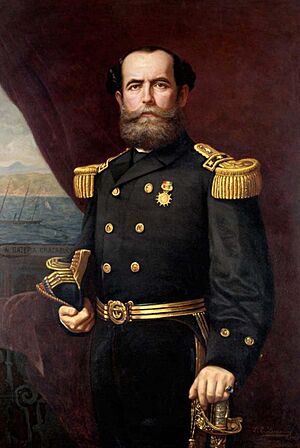Juan Williams Rebolledo facts for kids
Juan Williams Rebolledo (born in 1825 in Curacaví, Melipilla Province – died on June 24, 1910, in Santiago) was an important Chilean naval officer. He became a rear admiral, which is a high rank in the navy. In 1879, he was the main leader of the Chilean navy when the War of the Pacific began. He also worked as a politician, serving in the national Congress for Valparaiso in 1867 and as a city councillor in 1873.
Contents
Juan Williams Rebolledo came from a family of sailors. His father, John Williams Wilson, was an English-Chilean navy officer. His mother, Micaela Rebolledo, was Chilean. His father had moved to Chile from Bristol, England, to join Chile's new navy.
Juan Williams followed in his father's footsteps and joined the navy in 1844. He quickly moved up in rank. By 1855, he was in charge of the navy's shipyards and was also the maritime governor of Atacama, which was Chile's northernmost region at the time.
Heroism in the Chincha Islands War
In 1865, Williams became the captain of the ship Esmeralda. He sailed this ship during the Chincha Islands War, which was a conflict against Spain. During this war, he became a national hero. He famously captured the Spanish ship Covadonga at the Battle of Papudo on November 26, 1865.
After this war, he played a big role in training many officers. These officers later fought in the War of the Pacific. He also helped to completely reorganize and update the Chilean navy.
In 1867, Williams was chosen to be a Deputy in the Chilean Congress, representing the port city of Valparaíso. Six years later, he became a city councillor for the same city. In 1874, he was named the main commander of the Navy.
In 1879, when the War of the Pacific started against Peru and Bolivia, Williams was made the commander-in-chief of the Chilean navy. The government wanted him to attack the Peruvian navy right away. The Peruvian ships were being repaired in the port of Callao and were not ready for battle.
However, Williams disagreed with this plan. He wanted to block the southern Peruvian ports instead. His idea was to stop Peru from exporting nitrates, which was their main way of earning money. This delay gave Peru more time to get its navy ready. By the time Williams decided his blockade wasn't working fast enough, the Peruvian navy was prepared and at sea.
In late April 1879, Williams finally decided to attack Callao. He left his two oldest and slowest ships, Esmeralda and Covadonga, to block the port of Iquique. These ships were not fast enough to keep up with the rest of the fleet. On May 21, these two ships faced the Peruvian navy's main force during the Battle of Iquique and Battle of Punta Gruesa. Even though the Esmeralda was sunk, the Covadonga won its battle, which brought Williams praise. However, some historians believe his earlier hesitation caused problems.
Eventually, Williams had disagreements with other important leaders, like Rafael Sotomayor, the Chilean Minister of War, and General Justo Arteaga, the Army's Commander-in-Chief. These disagreements caused him to lose support. After he failed to capture the Peruvian ship Huascar, he resigned in August 1879. Captain Galvarino Riveros took his place.
Later Years and Legacy
After the war, Juan Williams Rebolledo held several other important positions in the navy. In 1890, he was promoted to Commander General. During a rebellion by the Chilean Navy that led to the 1891 Chilean Civil War, he resigned from his post. He chose to remain loyal to President José Manuel Balmaceda.
Two years before he passed away, the Chilean Congress gave him a special promotion to Rear-Admiral. He died in Santiago on June 24, 1910.
| Military offices
|
||
|---|---|---|
| Preceded by Luis Uribe |
Navy General Commander 1890-1891 |
Succeeded by Oscar Viel |
See also
 In Spanish: Juan Williams Rebolledo para niños
In Spanish: Juan Williams Rebolledo para niños


